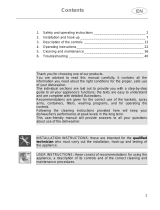
TABLE OF PROGRAMS
SETTING THE WASHING PROGRAM AND SWITCHING ON
To select the most suitable program for the dishes to be washed refer to the table below, which indicates the most appropriate program according to dish
type and degree of soiling.
After choosing the most suitable washing program using the table provided:
•
press the ON/OFF key (1) and wait for the INFORMATION DISPLAY (7) to come on;
•
press the PROGRAM SELECTION button (2) several ti mes, until the INFORMATION DISPLAY (7) shows the number corresponding to the progr am
of choice; close the door, the machine will automatically begin the washing program after the sounding of the acoustic device.
"P0" on the DISPLAY means that no washing program has been selected. This message remains until the PROGRAM SELECTION button (2) is pressed;
at this point the number of the last program used will appear. Each time the button is pressed again, the progr am number s will move on from that point
forward.
All programming operations are accompanied by a short confirmatory beep; if you do not hear anything when you press a button, the func tion concerned is
not available in the program selected.
AMOUNT OF
DET ERGENT
PROGRAM S EQUENCE DURATION CONSUMPTION
CYCLE N. EC O
BUTTON
EC O
DRYING
(OPTIONAL)
TYPE AND DEGREE
OF DI RT O N DIS HES
GRAM S PREWASH WASH COLD RINSE HOT RINSE DRYING M INUTES
(2)
WA TER
LITRES (1)
POWER
Kw h (2)
SOAK
1
_ _
PANS AND DISHES PENDING
COMPLETION OF THE LO AD
_
COLD
_ _ _ _
18' 4
_
DELICATE
2
_
DISHES WITH LIGHT DIRT
25
_
45°C 1 1 YES 68' 10 1,05
GLASSWARE
2
SLIGHTLY SOILED
DELICATE ITEMS
25
_
45°C 1 1 YES 65' 10 0,98
QUICK
3
_ _
DISHES WITH LIGHT DIRT
25
_
38°C 1 1
_
38' 10 0,4
NORMAL
4
_
NORMALLY SOILED PANS AND
DISHES
30
COLD
65°C 1 1 YES 95' 14 1,35
DAILY
4
NORMALLY SOILED DISHES
30
_
65°C 1 1 YES 90' 11 1,32
BIO
(*) EN 50242
5
_
NORMALLY SOILED PANS AND
DISHES, INCLUDING DRIED-ON
RESIDUE
30
COLD
55°C 1 1 YES 160'
(3)
14 1,05
(3)
ECO BIO
5
SLIGHTLY SOILED DISHES WITH
DRIED-ON RESIDUE
30
_
55°C 1 1 YES 100' 11 1,25
INTENSIVE
6
_
VERY DIRTY PANS AND DISHES,
EVEN WITH DRIED-ON DIRT
30
COLD
66°C 2 1 YES 110' 17 1,45
INTENSIVE
(WIT HOUT
PRE-WASH)
6
NORMALLY SOILED PANS AND
DISHES WITH DRIED-ON STARCH
DEPOSITS
30
_
68°C 2 1 YES 100' 14 1,42
SUPER
7
_
HEAVILY SOILED PANS AND DISHES
WITH DRIED-ON STARCH DEPOSITS
30
HOT
70°C 2 1 YES 115' 17 1,6
RINSE
(**)
8
_ _
DISHES THAT NEED
“FRESHENING UP”
_ _ _
1 1 YES 40' 7 0,8
In programs containing the symbol, the ECO drying cycle option is available. This ac tivates the ventilation system which allows the dishes to be
dried at lower temperatures (energy savi ng). With this option active, the progr am times are longer (about 50’ for the BIO no. 5 program and about 20’ for
all the other cycles).
Only run the soak program with half loads.
The HALF LOAD option (6) is available for all
programs except the soak program.
ECO DRY (5) and HALF-LOAD (6) functions
are only present on some models.
(*) Reference program as EN 50242 standard
(program recommended when using “new
generation” detergents containing enzymes).
(**) Before starting program 8 check that the
door of the detergent dispenser is open.
(-) Not present.
(1) Average power consumption with the
softener set on level 2.
(2) The cycle duration and power consumption
may vary according to the water and room
temperatures, and the type and amount of
dishes.
(3) With ECO DRY function selected.
If the dishwasher door is left open or
is not properly closed, the
INFORMATION DISPLAY (7) will
signal that the washing program
cannot be started.
For any other information about use
and maintenance of the dishwasher,
read the enclosed manual carefully.
19 592 0014 00 AAA




















